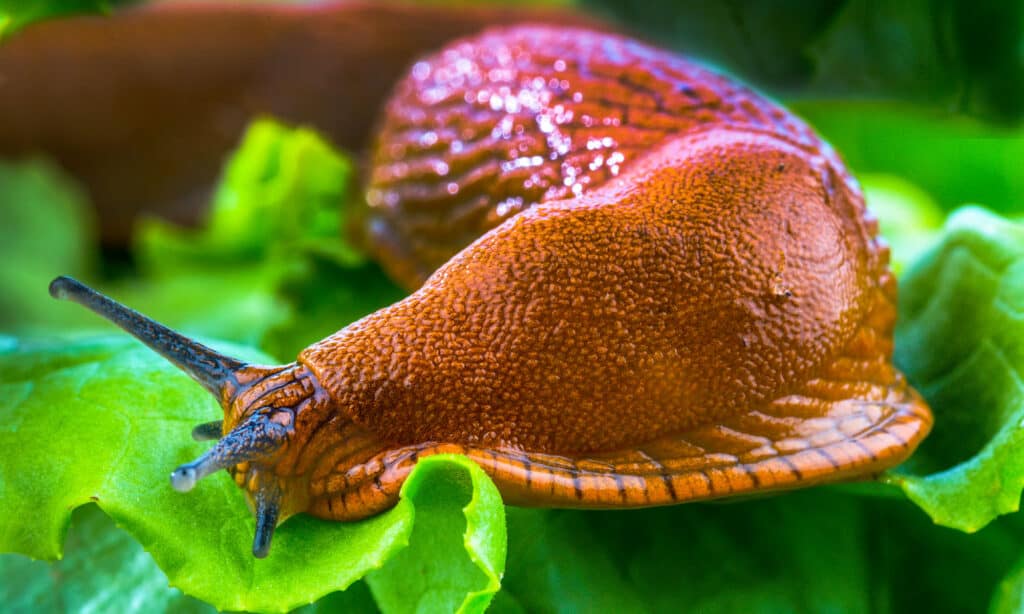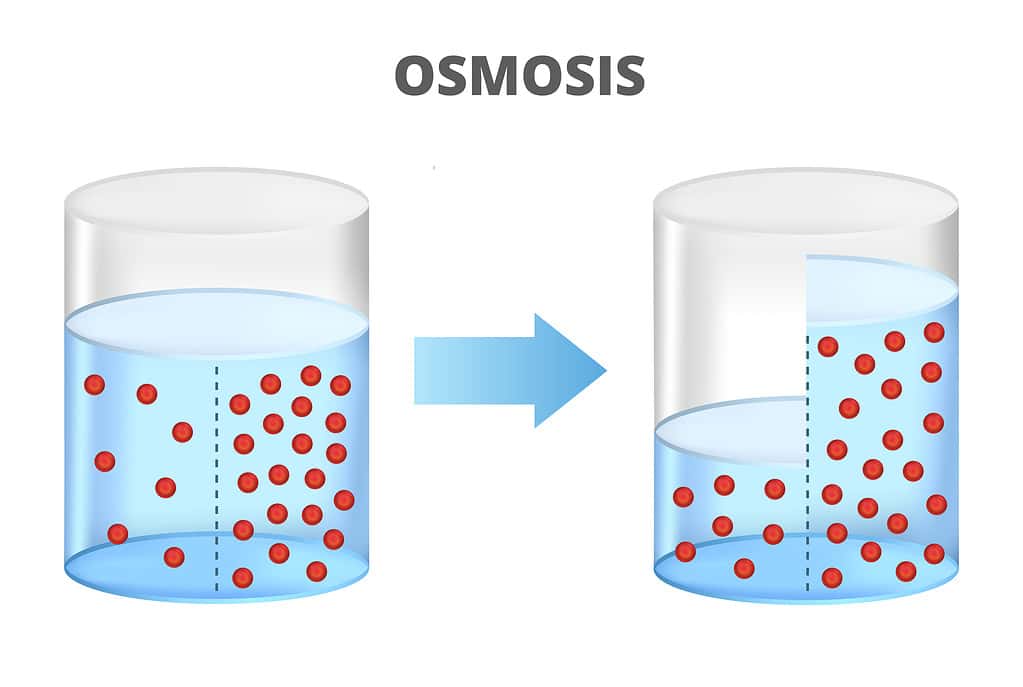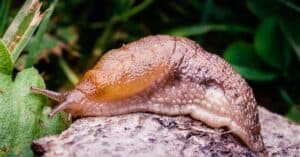Oh, those slimy slugs! Even if you think they are kind of cute, you don’t want them eating up your garden. You could try using tools like slug collars or other barriers to protect your precious plants, but many people opt to kill them with salt. This is not the most humane thing to do to a slug, but most people do not choose to attempt to relocate slugs away from their gardens. They opt for a quick and easy kill. When you’re dealing with dozens or even hundreds of slugs, and the thought of stomping them really grosses you out, here’s what you need to know before you grab your salt shaker and go at it. Read on to discover why salt kills slugs so quickly.

Slugs can eat plants faster than they can grow.
©Dieter Hawlan/iStock via Getty Images
Anatomy of a Slug
To understand why salt kills slugs so quickly, we must first understand a little bit about the anatomy of a slug. Slugs are mollusks called gastropods. Gastro means stomach, while pod means foot. The large, back portion of a slug is called its foot. Slugs use their muscular foot to move around. They secrete a slimy mucus trail that helps them to slide along more easily.
These invertebrates have very simple structures with no skeletons to help them maintain their shape. Their bodies are mostly made of water. A mucus coating helps to protect them. They live in moist environments, usually under rocks, logs, landscape timbers, flowerpots, dead leaves or mulch, or anyplace else where it stays moist and cool. They live in constant risk of drying out and dying, so they tend to come out only at night or after it rains.

Slugs must maintain a mucus covering on their skin to prevent dehydration.
©Lisa-S/Shutterstock.com
Slugs can drink water or absorb water through their skin, but because their skin is semi-permeable, they can easily lose water that way, too. Without their protective mucus, they would struggle constantly to maintain the balance of water they need to keep their cells alive. Even with the mucus, dehydration is perhaps their greatest threat to survival. This helps explain why salt kills slugs so quickly.
Osmosis and How It Works
Osmosis is the process by which water moves across a semi-permeable membrane from an area of lower concentration of a solute to an area of higher concentration of solute. The word solute means a substance dissolved in water, such as sugars or salts. The diagram below shows how osmosis works.

Osmosis moves water from areas of low solute concentration to areas of high solute concentration to achieve equilibrium.
©petrroudny/iStock via Getty Images
In the image on the left, there are equal amounts of water on both sides of a membrane, but there is a higher concentration of solute, represented by red dots, on the right side of the membrane than on the left. In the image on the right, water has moved across the membrane so that the concentration of solute on both sides is roughly equal. There is still the same amount of solute on both sides of the membrane. Count the dots and see. But now the right side has more water, so the concentration has become more equal.
Approaching Equilibrium
The goal of osmosis is to reach a point known as equilibrium. Equilibrium exists at the point where the concentration of a solute, such as sodium chloride, on both sides of a membrane is equal. So, if the salt content on one side of a membrane was 5 percent, and the salt content on the other side of a membrane was 15 percent, water would seep through the membrane until both sides had a concentration of 10 percent salt.
How Salt Kills Slugs
When you sprinkle salt on a slug, it mixes with the water in the slug’s mucus covering. It creates a solution that has a high salt concentration. Because the slug’s skin is semi-permeable, water instantly begins seeping through from the slug’s cells to try to regain equilibrium. The more salt you have sprinkled on the slug, the more water it will lose from its cells. The slug dehydrates and dies a, presumably, unpleasant death.
Why Doesn’t Saltwater Kill Sea Slugs?
You may wonder, what about all the beautiful species of sea slugs that live in saltwater? If salt kills land slugs, why doesn’t saltwater kill sea slugs? The answer lies in the concentration of the solute. Pretty much all living things have some level of salts in the fluid inside their cells. Sea water has roughly the same concentration of salt as the water inside the cells of the slugs that live there. Therefore, not much water needs to pass in or out of the sea slug to maintain equilibrium. Therefore, they survive easily in the sea.

Sea slugs survive saltwater because it has roughly the same salt concentration as their cells.
©cbpix/Shutterstock.com
Why to Avoid Salting Slugs
Although salt kills slugs quickly, it is not an effective way to deal with slugs in your garden. Salting slugs in your garden means salting the soil around your plants as well. Adding salt to the soil can change the pH balance and damage or even kill your plants. You don’t want that. If you are dealing with a slug infestation in your garden, consider using protective barriers, along with slug bait to draw the pests away from your plants instead of damaging the soil around them.
Also, remember that only a few of the myriad of slug species are actually harmful to crops. You don’t need to kill every slug you see. They are a vital food source for many animals, including birds, mammals, reptiles, and amphibians. And as long as they aren’t eating up your plants, they won’t do you any harm. In fact, they might even help by decomposing dead plant and animal matter and eating worms, bugs, and even other, more destructive mollusks like snails.
The photo featured at the top of this post is © Lisa-S/Shutterstock.com
Thank you for reading! Have some feedback for us? Contact the AZ Animals editorial team.





